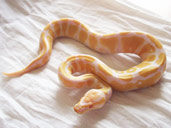 |
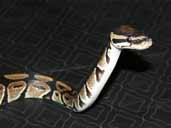 |
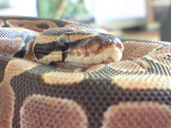 |
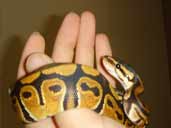 |
Royal Python Care Sheet
Common Name: Royal Python or Ball Python
Scientific Name: Python Regius
Description
Description: Royal Pythons are large bodied snakes, which come in a range of colour variations and morphs. Generally, normal Royals are earthy colours like brown, beige and black with gold and white markings.
Size: Up to 5 ft (1.5M) in Length. Females tend to grow larger than Males.
Life Span: 20 - 30 years is average for a Royal Python in captivity, but it is not uncommon for them to reach 40 years with appropriate care.
Origin: Western, Eastern and Central Africa
Habitat: They are a terrestrial species that are active at night and hide away during the day. They prefer life on the ground and frequent forest floors and grassy savannas in their natural habitat.
Things to consider before purchasing your first Royal Python:
-
Who will look after your new pet if you are away?
-
Can you get food easily from your local pet shop?
-
Can you live with dead mice in your freezer?
-
Can you handle feeding the mice to your pet?
-
Are you prepared to take on an animal that could live for up to 30 years?
-
Is the rest of the family happy to live with a pet snake?
- Can you afford all the equipment necessary to keep your pet happy?
- Have you done your research on Royal Pythons and their relevant care?
You should also consider the availability of Royal Pythons in your area and find out as much about local reptile stockists and breeders before deciding where to purchase your Royal Python from. It is advisable to buy your snake from a reputable stockist and ensure that they have enough information about the snake's history before you decide to buy. Never buy a snake without adequate feeding and shedding records, as these can tell you a lot about your Royal Python's state of health. Problem feeders and bad shedders can cause a lot of worry, so ensure that your Royal Python eats regularly and sheds well before you decide to buy.
You will also need to know where your Royal Python originated from. Most Royal Pythons in the UK are generally captive-bred specimens and these would be purchased either direct from the breeder or from a shop who will be able to guarantee captive-bred. Look out for 'CB' on the snakes container, which would indicate that the Royal Python was bred from captive parents. Other abbreviations to look out for are 'WF' and 'WC'. WF stands for 'Wild Farmed', which means that you're Royal Python was created by semi-wild parents on a farm, who's eggs/young were collected then imported from Africa. WC stands for 'Wild Caught', which means that your Royal Python was hatched in the wild and then imported out of Africa for the pet trade. It is recommended that whenever possible you should purchase a captive-bred specimen.
Choosing your Royal Python
Always insist on handling your snake before you decide to buy. This will allow you to notice any health or temperament issues before you take your Royal Python Home. A healthy Royal Python will be alert, bright eyed and flicking it's tongue regularly during handling. The skin should be smooth and firm and there should be no traces of retained shed anywhere along the snakes body. If you are in any doubt about the snake's health and well-being then do not purchase it.
Royal Pythons can be transported home over short distances in either a RUB (Really useful box/plastic tub with lid) or a cotton bag tied at the top. Most reptile stockists would provide these, but a private seller may not.
Quarantining your new Royal Python is good practice if you have other snakes in the household. 2-3 months should be a minimum quarantine period.
Royal Python Morphs
 |
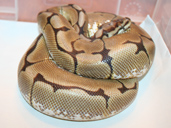 |
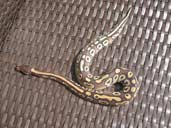 |
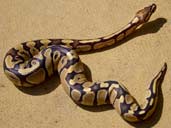 |
Albino Royal Python |
Spider Royal Python |
Mojave Royal Python |
Fire Royal Python |
There are a wide variety of Royal Python morphs available both in the UK and abroad. Each morph is a genetic mutation of the common Royal Python, which is either naturally occurring or brought about and emphasized by selective breeding in captivity. Some breeders take years to develop certain morphs by breeding different mutations together to create new or super designer morphs. Understandably, the price you would pay for a special morph is much higher than what you would pay for a common Royal Python, but if you are prepared to pay the price, then you are more likely to gain your money back through your own breeding projects.
Royal Python morphs have the same care needs as a common Royal Python, so the cost of keeping a morph or a normal are the same, it is just the initial purchase price that is extravagant.
Captive Care
Temperament: They have a very docile temperament, as they are more likely to curl up in a ball to protect themselves than strike at a potential threat. They are easy and safe to handle, despite their size, and make a good choice for people who are new to snake keeping.
Handling: Royal Pythons are quite a timid species and some do not appreciate being handled for long periods of time. Regular handling is still important though, to allow your snake to get used to human contact and to exercise outside of the vivarium.
Although Royal Pythons do grow quite large, they are relatively easy to handle. They are slow moving compared to other types of pet snake, but are quite clumsy so should be handled with care. A fall from a height could injure your snake, so take care to support your Royal Python's body during handling.
Shedding: Royal Pythons, like all other snakes, shed their outer layer of skin periodically throughout their lives. Young snakes may shed more frequently than adult snakes, but in general the shedding process occurs several times a year. This is nothing to worry about as a keeper, but there are a few things you can do to help your snake through this process.
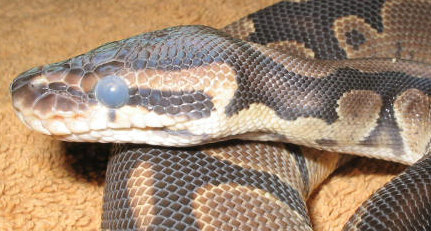 Preecdysis is the name given to the changes your snake will go through whilst preparing to shed it's skin. This will include a dulling of your snake's skin colour, general inactivity and their eyes will turn a bluish grey colour. At this time your Royal Python may refuse a feed or shy away from being handled, but this depends on the individual snake and how they handle preecdysis. While your snake is 'in blue' it is advisable to handle with care as their vision is obscured by the membrane covering it's eyes and they may feel more insecure than usual, therefore more likely to be defensive.
Preecdysis is the name given to the changes your snake will go through whilst preparing to shed it's skin. This will include a dulling of your snake's skin colour, general inactivity and their eyes will turn a bluish grey colour. At this time your Royal Python may refuse a feed or shy away from being handled, but this depends on the individual snake and how they handle preecdysis. While your snake is 'in blue' it is advisable to handle with care as their vision is obscured by the membrane covering it's eyes and they may feel more insecure than usual, therefore more likely to be defensive.
Some snakes will handle a shed without any need for extra help, but if you want to assist your snake during this time you should try to raise the humidity in your vivarium to help your snake loosen it's skin. You can do this by placing a larger water bowl in the vivarium so that your snake has the opportunity to soak itself if desired. You can also lightly mist the tank with water to help raise the humidity. Another useful tactic is to place a humidity box in the Vivarium. This can be a sandwich box with a hole cut in 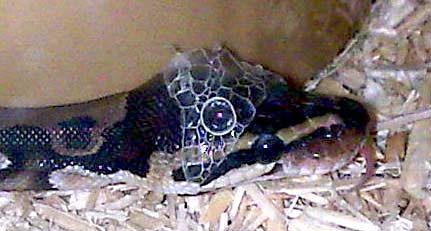 the top filled with damp sphagnum moss. Your Royal Python should appreciate the extra humidity and it will make the next stage in the process easier for it.
the top filled with damp sphagnum moss. Your Royal Python should appreciate the extra humidity and it will make the next stage in the process easier for it.
Ecdysis is the act of shedding, which is usually started by your snake rubbing it's head on rocks or decor to loosen the skin around it's head. Once it has worked it's head free it will continue to crawl its way out of the old skin by rolling it inside out has it moves. Once your snake has shed it's skin it should be removed from the vivarium along with any faeces that usually accompanies Ecdysis. Check your snake to ensure that the shed skin has successfully been removed, taking particular notice that the eyecaps and tail end have not been retained. If necessary bathe your snake and remove any patches of skin that have not been shed with a warm towel or tweezers, to avoid infection or death of the tissue below it.
Keeping Notes: Record keeping is a good way of monitoring your Royal Python as it grows and develops. It is advisable to keep a written record of when your snake feeds and sheds it's skin, so that you have a resource to refer to if there becomes a problem. Regular weight and length checks are also useful as you can monitor the growth of your Royal Python, which helps to ensure that your Royal is healthy.
Feeding
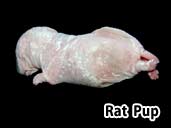 |
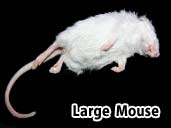 |
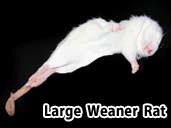 |
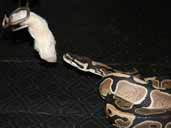 |
Royal Pythons feed on mice or rats appropriate to the size of their mouth.
Hatchlings start on fluffy mice, one every 5-6 days and graduate up to an adult mouse every 7-10 days as they grow. Very large snakes may require 2 adult mice per feed or even the introduction of larger prey items such as rats, Guinea Pigs and small rabbits. You may also feed a mature Royal Python on day old chicks to provide a variation in diet. Do not feed your snake with live food, even a small mouse may bite or injure your snake. Shop brought frozen rodents are available from most pet shops or bought over the internet; these can be thawed to room temperature and make an excellent all round food for your snake. Wild rodents carry parasites and should be avoided at all times.
Never handle your snake straight after a feed, as it will regurgitate its meal. It is recommend to leave your Royal at least 48 hours after feeding before handling. Snakes that are preparing to shed their skin, rarely feed until after they have shed.
Feeding your Royal Python outside the vivarium is recommended to ensure that no substrate is ingested along with the prey item. If a Royal Python ingests large amounts of it's substrate then it can lead to your snake becoming impacted and ill.
If your snake is reluctant to feed, which is likely in a Royal Python, then there are a few techniques you can try to encourage your snake to feed. One of these is 'braining' the mouse. Snakes are attracted to the scent of brain matter, so if you cut into the skull of the mouse to expose the brain tissue, then they are more likely to take the food item.
Since Royal Pythons are notoriously bad eaters, as they will refuse a feed if they are stressed, being over-handled or are not kept in the correct conditions, it is best not to worry if your Royal Python misses the occasional meal. Concentrate on resolving the cause of your Royal's anxiety and they will usually begin feeding again once they become more comfortable.
Housing
Royal Pythons are not highly active and do not need huge enclosures. A medium sized vivarium (Even a fish tank with a tight fitting lid) will house your Royal nicely. The vivarium should allow a minimum of 1 square foot of floor space to each foot of snake and be approximately a third of the snake’s length in height. Hatchlings should start out in an appropriately sized small vivarium as they can become stressed and stop feeding in an oversized vivarium.
All Snakes are excellent escape artists, so care must be taken when planning their housing. Make sure your vivarium or tank has a tight fitting lid, which can be clamped down. Royal Pythons are very strong and can push a loose fitting lid from a vivarium.
Royal Pythons may grow up to 5ft in length, but do not necessarily need a large vivarium. They will feel more secure in a suitably sized vivarium, which should be around 3ft(L)x2ft(W)x2ft(H) for an adult, dependant on how big your Royal Python grows.
Your Royal Python vivarium should contain:
Substrate
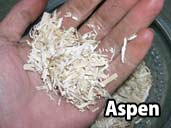 |
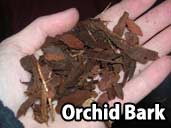 |
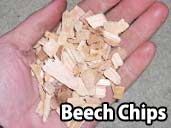 |
 |
With Royal Pythons, there are a couple of different substrates that can be used:
Aspen Shavings: Aspen shavings may be used for Royal Pythons. The shavings cannot be cleaned and so have to be removed and replaced with fresh shavings when dirty. If you use aspen shavings the urine and faeces can be scooped out with a cat litter scoop, and replaced with fresh shavings as needed. Be sure to remove soiled substrate as soon as possible; urine-soaked material will become a breeding ground for bacteria, which could harm your Python. If you use this type of substrate you will have to place your snake in a secure area to feed it; you do not want it to ingest any of the shavings.
At least once a month, all shavings should be removed and disposed of, and the entire enclosure cleaned and disinfected before new shavings are placed inside.
Do not use Cedar or Redwood Shavings these are toxic for all animals and should never be used in predator or prey enclosures. Cedar and redwood should not be used in constructing housing for any animal, nor in any furniture or paneling in a vivarium in which any animals are housed.
Beech Chippings: Beech Chippings are readily available from most Reptile shops and are quite an attractive substrate to have in the vivarium. It comes in three different grades - small, medium or large, so you can choose the size which is most suitable for your snake. It allows for spot cleaning, although it is not as absorbent as Aspen. It is not a good substrate for burrowing snakes.
Newspaper: Layers of newspaper have been used for years in animal keeping. It is relatively absorbent when several layers are used, and inexpensive to replace. However, the inks used in printing are known to be harmful to animals. Unprinted sheets may be obtained at shops selling moving supplies, or roll ends may be obtained from some newspaper companies. As with printed newspaper, it is relatively absorbent when several sheets are used, especially when layered with paper towels. Unlike printed newspaper, the unprinted sheets and rolls are not impregnated with potentially harmful inks that could harm your Royal Python.
Paper Towels: Easily obtained and relatively inexpensive, paper towels make an excellent substrate for reptiles with belly injuries and those in the early stages of quarantine.
Coco/Orchid Bark: Some reptile shops may recommend the use of Coco or Orchid bark for Royal Pythons, but this substrate is more appropriate for snakes that require higher humidity levels. It is safe to use as long as you monitor the humidity of the vivarium regularly and ensure that your Royal Python is comfortable with the conditions.
Astroturf® / Artificial Grass: Astroturf® was the first artificial grass floor covering. Since then, carpet manufacturers have come out with many grades of artificial grass. Hardware shops usually have two or more grades. The least expensive is generally the best to use. It is more flexible, a key factor for thorough cleaning and disinfecting. Pieces can be washed and disinfected repeatedly before they require replacing. Astroturf® is cheap enough that several pieces can be cut for each enclosure and rotated each cleaning day. The pieces of artificial grass substrate sold in small, prepackaged pieces in many pet shops and mail order pet suppliers are the same as the product sold in builder supply shops.
Place for your Royal Python to hide
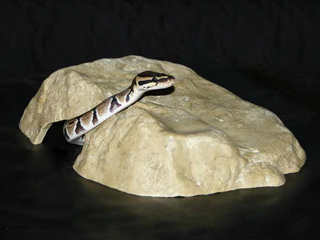 All Royal Pythons need somewhere to hide and may become stressed if this is not provided. This could be a cardboard box, which can be easily replaced if it becomes soiled.
All Royal Pythons need somewhere to hide and may become stressed if this is not provided. This could be a cardboard box, which can be easily replaced if it becomes soiled.
Specialist reptile hides can be purchased from pet shops and over the Internet; these can be cleaned when you clean the rest of the vivarium once a month.
Any hide should be just large enough for your Royal Python to curl up in; if it is too large the snake will not feel as secure.
In general, it is wise to place two hides in your vivarium for your Royal to use, one in the warm side of the vivarium and one in the cooler side. This enables your snake to have adequate hiding places along the temperature gradient, which would allow your snake to adjust its body temperature. This is important, because for Royal Pythons, the instinct to hide is often more insistent than the instinct to keep at the right temperature. If the snake does not control his body temperature it can lead to many problems, the least of which being digestive problems.
A place to climb
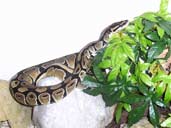 Branches and plastic plants can be bought from pet shops and over the internet these provide a place for climbing and resting, they also aid the snake when shedding its skin.
Branches and plastic plants can be bought from pet shops and over the internet these provide a place for climbing and resting, they also aid the snake when shedding its skin.
Branches collected from the wild will need to be debugged by soaking first in chlorine/water solution, then rinsed thoroughly, soaked in clean water, then left to dry in the sun. Some live plants may be harmful to your Python, if in doubt don't use them in your vivarium.
Repti-vine is widely available and may also be appreciated by your Royal Python. This is safe to use, easy to clean and comes in a range of thicknesses to ensure that it is stable enough for your Royal Python to climb upon.
A change of scenery
Royal Pythons are very inquisitive animals and like to explore new surroundings. Once in a while change the layout of the vivarium; this will keep your Royal from becoming bored. You will notice once you put your snake back in the tank it will start to re-explore its new surroundings.
Water Bowl
All Royal Pythons need fresh water to drink daily. Water should be given in a reasonable sized bowl which is fairly heavy to stop your snake tipping it over.
Water can also help your snake during shedding at this time your snake may be found bathing in the water.
If the snake defecates in its water bowl, the bowl must be cleaned and disinfected immediately.
Heating Equipment
Royal Pythons are cold blooded and get heat from their surroundings. In the wild snakes bask in the sun to keep warm or move to a shady spot if they are too hot, this is called thermo-regulation. The ideal temperature for you snake's vivarium is a temperature gradient of 26-33°C (80-91°F).
Royal Pythons are large bodied snakes, therefore we do not recommend using a heat mat if your snake is in a vivarium setup, this is due to the risk of thermal blocking (Where the shear weight of a large bodied snake causes hot spots on the heat mat due to the heat reflecting back from the vivarium floor and into the snake). Thermal blocking can cause severe burns when heat mats are used inside the vivarium. Heat mats do have their place if used under a RUB (Really useful box) or in a stack system, but MUST be used with a mat stat.
Heat should be therefore be provided using a ceramic heater with pulse thermostat and bulb guard. Ceramic heaters/bulbs give a good ambient air temperature which is preferred by heavy bodied snakes such as Royal Pythons.
Ceramics should be set up at one end of your vivarium to allow your snake to thermo-regulate.
A popular alternative to a ceramic is a normal light bulb or an infra red on the roof of the vivarium, attached to a dimming stat. It is important to ensure that the heat source is protected from direct contact with your snake by using a guard. Royal Pythons do not feel heat in the same way that we do and do not always realise that something they are touching is burning them. A bulb guard will ensure that your Royal Python will stay a safe distance away from the heat of the bulb so burns will be avoided. The disadvantages of using a bulb as a heat source is that the bulb needs to be turned on constantly to keep the vivarium at the correct temperature. Your Royal Python does not require light 24 hours a day and can suffer from stress if the light exposure is too long. It is recommended to keep your Royal Python in a natural light pattern that mimics normal daytime, so a ceramic heater is a better choice between the heat sources. If you do decide to use a ceramic, then a energy-saving bulb with guard can be added to the vivarium for decorative purposes to help you see your snake.
A ceramic bulb can be purchased from most reptile shops and is a good heat source for Royals as it raises the ambient air temperature of the vivarium. Adult Royals are said to prefer higher air temperature. Ceramic heaters must be used with both a pulse thermostat and a bulb guard. They can reach high temperatures and you should check the wattage of the ceramic before purchasing, as the wattage of the ceramic is dependant on the size of the vivarium you are trying to heat. Ceramic bulbs last longer than normal light bulbs and do not cause light-stress.
It's useful when using both methods to have a small thermometer on either end of the vivarium to check the temperature. Place the thermometers near the hides on top of the substrate as this is where your Royal Python will spend the majority of it's time. One end should be around 33°C and the other around 24°C. Checking temperatures regularly is advised to ensure that your Royal Python can thermo-regulate by moving around the tank
Hydrometer
 Royal Pythons require an humidity level of around 50-60%, so it is advisable to buy a Hydrometer to monitor this. 50% is usually around room humidity so most keepers do not need to worry about humidity levels if the vivarium is set up correctly.
Royal Pythons require an humidity level of around 50-60%, so it is advisable to buy a Hydrometer to monitor this. 50% is usually around room humidity so most keepers do not need to worry about humidity levels if the vivarium is set up correctly.
If the humidity in your vivarium is too low, then a damp hide can be added. The easiest way to create a damp hide is to buy some Sphagnum Moss. Soak the moss in water, then squeeze as much liquid out as possible and place it in a hide for your Royal Python to use. Another method for upping the humidity levels is to lightly spray the sides of the vivarium with a misting of water from a spray bottle. Caution must be used when using this method, due to the proximity to the electrical equipment in your vivarium set up.
If the humidity in your vivarium is too high then extra ventilation is needed. Spare vents can be easily ordered from online suppliers, but care should be taken when fixing the additional vents in place, so that your vivarium does not become damaged. It is important that the humidity level does not remain high as this can lead your Royal Python to develop a R.I (respiratory infection).
Common Complaints
Royal Pythons are a hardy snake that would rarely become ill with appropriate care, but here is a quick introduction to a few disorders that need to be looked out for.
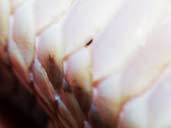 Mites: Mites are little black parasites that live on your Royal Python and feed on their blood. If your Royal Python catches mites they can usually be found around the eyes, mouth and under scales. Your snake will seem lethargic and may go off it's food during a mite infestation. If you discover mites on your Royal Python, immediately bathe your snake in warm water and fully disinfect the entire tank and contents. Refill your vivarium with white kitchen roll and leave the cage furniture to a minimum. This helps stops the mites being able to breed as they need substrate to lay eggs and also allows you to see them more clearly while you monitor your snake. Repeated bathing and disinfecting of the vivarium helps, but it unlikely that you will remove a mite infestation without some sort of treatment. Reptile shops sell various treatments to help kill off the mites, but some vets may prescribe a weak dose of Frontline if they feel it is necessary.
Mites: Mites are little black parasites that live on your Royal Python and feed on their blood. If your Royal Python catches mites they can usually be found around the eyes, mouth and under scales. Your snake will seem lethargic and may go off it's food during a mite infestation. If you discover mites on your Royal Python, immediately bathe your snake in warm water and fully disinfect the entire tank and contents. Refill your vivarium with white kitchen roll and leave the cage furniture to a minimum. This helps stops the mites being able to breed as they need substrate to lay eggs and also allows you to see them more clearly while you monitor your snake. Repeated bathing and disinfecting of the vivarium helps, but it unlikely that you will remove a mite infestation without some sort of treatment. Reptile shops sell various treatments to help kill off the mites, but some vets may prescribe a weak dose of Frontline if they feel it is necessary.
Respiratory Infections (R.Is): R.Is are a bacterial infection that is usually caused by poor cage conditions, low temperatures or too much humidity, but can be passed from snake to snake too. Royal Pythons may sound wheezy with excessive saliva and nasal discharge. Their mouths may also gape open as your Royal struggles to breathe. Very mild R.Is may go away themselves if the conditions that the snake are living in are corrected, but serious infections need to be seen to by a vet immediately to avoid Mouth Rot or even death of your Royal Python. The vet may prescribe an anti-biotic called Baytril, which is safe enough to be given to your snake.
Regurgitation: When a snake regurgitates it's meal, it may not necessarily be down to illness, but as regurgitation is a symptom of many digestive problems, illnesses and stress it is recommended that if your Royal Python does regurgitate it's meal that you monitor your snake very closely for further symptoms. Sometimes a Royal Python may regurgitate it's meal if it is handled too soon after a feeding or if it has been fed an item that is too large for it. In this case, you should leave the snake to settle back down for a week before trying to feed again. If your Royal Python repeatedly regurgitates it's meal, loses excessive weight or shows any other signs that are worrying you, seek medical attention as soon as possible.
Further Information
This care sheet is a simple step-by-step guide to successful Royal Python keeping, but if you have anymore questions or need more specific information about the keeping of Royal Pythons, please enter our forum. It is a useful resource where you can ask members to share good practice and also talk about your experiences of being a Royal Python keeper.

